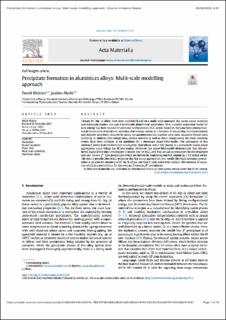| dc.contributor.author | Kleiven, David | |
| dc.contributor.author | Akola, Jaakko | |
| dc.date.accessioned | 2021-09-03T07:22:26Z | |
| dc.date.available | 2021-09-03T07:22:26Z | |
| dc.date.created | 2020-10-16T14:21:16Z | |
| dc.date.issued | 2020 | |
| dc.identifier.citation | Acta Materialia. 2020, 195 123-131. | en_US |
| dc.identifier.issn | 1359-6454 | |
| dc.identifier.uri | https://hdl.handle.net/11250/2772719 | |
| dc.description.abstract | Ternary Al–Mg–Si alloys have been modelled based on a multi-scale approach that spans across atomistic and mesoscale models and uses theoretically determined parameters. First, a cluster expansion model for total energy has been trained for atomistic configurations (FCC lattice) based on the data from density functional simulations of electronic structure. Free energy curves as a function of solute (Mg, Si) concentrations and disorder have been obtained by using this parameterisation together with meta-dynamics Monte Carlo sampling. In addition, free energy data, surface tensions as well as strain energy using the linear elasticity theory have been collected to be combined for a mesoscale phase-field model. The application of this approach shows that the formation of a layered MgSi phase, with (100) planes, is a particularly stable solute aggregation motif within the Al host matrix. Moreover, the phase-field model demonstrates that the preferred shape of the MgSi precipitates is needle-like (in FCC), and they can act as precursors for the important and well-known β″-type precipitates which are formed by translating one Mg column by a 1/2 lattice vector. The results provide theoretical evidence that the solute aggregation into needle-like MgSi domains (precipitates) is an inherent property of Al-Mg-Si alloys, and that it takes place even without the presence of vacancies which is a precondition for the eventual formation β″ precipitates. | en_US |
| dc.language.iso | eng | en_US |
| dc.publisher | Elsevier | en_US |
| dc.rights | Navngivelse 4.0 Internasjonal | * |
| dc.rights.uri | http://creativecommons.org/licenses/by/4.0/deed.no | * |
| dc.title | Precipitate formation in aluminium alloys: Multi-scale modelling approach | en_US |
| dc.type | Peer reviewed | en_US |
| dc.type | Journal article | en_US |
| dc.description.version | publishedVersion | en_US |
| dc.source.pagenumber | 123-131 | en_US |
| dc.source.volume | 195 | en_US |
| dc.source.journal | Acta Materialia | en_US |
| dc.identifier.doi | 10.1016/j.actamat.2020.05.050 | |
| dc.identifier.cristin | 1840197 | |
| cristin.ispublished | true | |
| cristin.fulltext | original | |
| cristin.qualitycode | 2 | |

